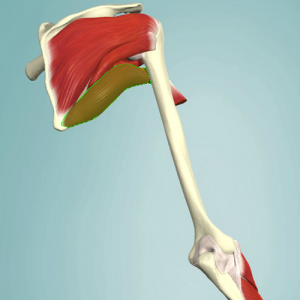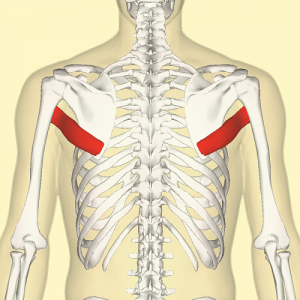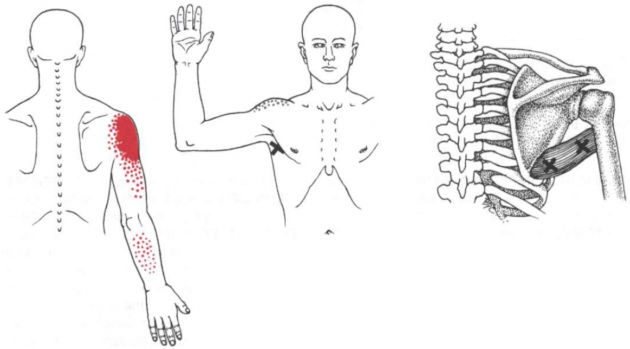Teres Major
Original Editor - Evan Thomas
Top Contributors - Evan Thomas, Lucinda hampton, Joao Costa, Kim Jackson, WikiSysop, 127.0.0.1, Admin, Oyemi Sillo and Naomi O'Reilly
Description[edit | edit source]
Teres major is a small, round muscle lying along the lateral border of the scapula. It forms the inferior border of both the triangular space and quadrangular space.
| [1] | [2] |
|---|
Anatomy[edit | edit source]
Origin[edit | edit source]
- Posterior surface of the inferior angle of the scapula[3]
Insertion[edit | edit source]
- Medial lip of intertubercular suclus of humerus[3]
Nerve Supply[edit | edit source]
- Lower subscapular nerve[3]
Blood Supply[edit | edit source]
- Circumflex scapular artery[3]
Function[edit | edit source]
Actions[edit | edit source]
Functional contributions[edit | edit source]
Trigger Point Referral Pattern[edit | edit source]
TrPs in teres major muscle typically refer pain into the posterior deltoid region and over the long head of the triceps brachii, as well as into the posterior shoulder joint, occasionally into the dorsal aspect of the forearm, and rarely into the scapula or elbow.[4]
Techniques[edit | edit source]
Palpation[edit | edit source]
Length Tension Testing / Stretching[5][edit | edit source]
- With the patient in supine, flex the patient's shoulder to 180deg with one hand by holding on the forearm
- Stabilize the scapula along the lateral boarder with the other hand
- With the hand holding the forearm, externally rotate the arm
- Both the moving hand and the hand stabilizing the scapula are used to sense the amount of muscle tension and barrier
Recent Related Research (from Pubmed)[edit | edit source]
Extension:RSS -- Error: Not a valid URL: Feed goes here!!|charset=UTF-8|short|max=10
Resources[edit | edit source]
References[edit | edit source]
- ↑ http://www.primalonlinelearning.com/cedaandp/muscular_system/muscles_of_the_lower_limb.aspx#bicepsfemoris
- ↑ http://en.wikipedia.org/wiki/Teres_major_muscle
- ↑ 3.0 3.1 3.2 3.3 Netter FH (2014). Atlas of Human Anatomy (6th ed). Philadelphia, PA: Saunders-Elsevier.
- ↑ Travell JG, Simons DG, Simons LS (1998). Travell and Simons' Myofascial Pain and Dysfunction: The Trigger Point Manual, Volume 2: The Upper Half of Body (2nd ed). Baltimore, MD: Williams & Wilkins.
- ↑ Sanzo P, MacHutchon M (2015). Length Tension Testing Book 2, Upper Quadrant: A Workbook of Manual Therapy Techniques (2nd ed). Canada: Brush Education.









